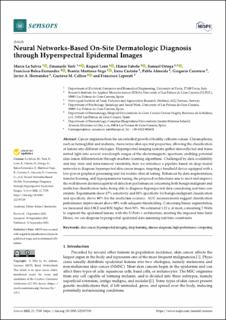| dc.description.abstract | Cancer originates from the uncontrolled growth of healthy cells into a mass. Chromophores, such as hemoglobin and melanin, characterize skin spectral properties, allowing the classification of lesions into different etiologies. Hyperspectral imaging systems gather skin-reflected and transmitted light into several wavelength ranges of the electromagnetic spectrum, enabling potential skin-lesion differentiation through machine learning algorithms. Challenged by data availability and tiny inter and intra-tumoral variability, here we introduce a pipeline based on deep neural networks to diagnose hyperspectral skin cancer images, targeting a handheld device equipped with a low-power graphical processing unit for routine clinical testing. Enhanced by data augmentation, transfer learning, and hyperparameter tuning, the proposed architectures aim to meet and improve the well-known dermatologist-level detection performances concerning both benign-malignant and multiclass classification tasks, being able to diagnose hyperspectral data considering real-time constraints. Experiments show 87% sensitivity and 88% specificity for benign-malignant classification and specificity above 80% for the multiclass scenario. AUC measurements suggest classification performance improvement above 90% with adequate thresholding. Concerning binary segmentation, we measured skin DICE and IOU higher than 90%. We estimated 1.21 s, at most, consuming 5 Watts to segment the epidermal lesions with the U-Net++ architecture, meeting the imposed time limit. Hence, we can diagnose hyperspectral epidermal data assuming real-time constraints. | |
